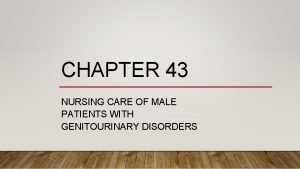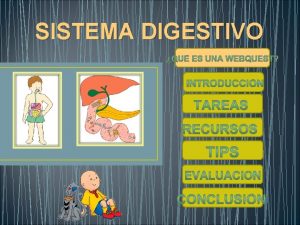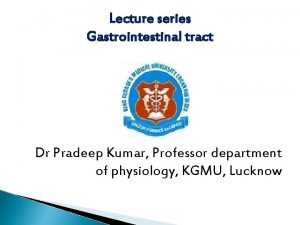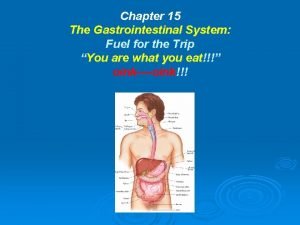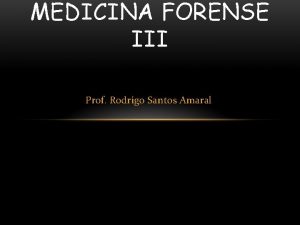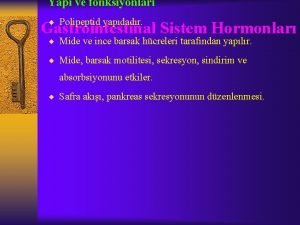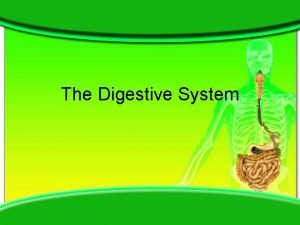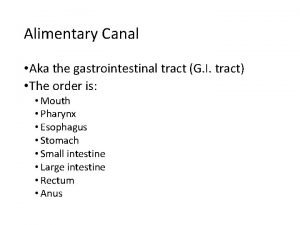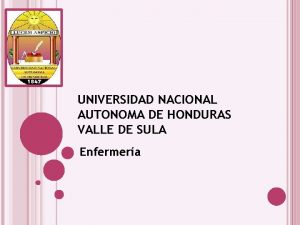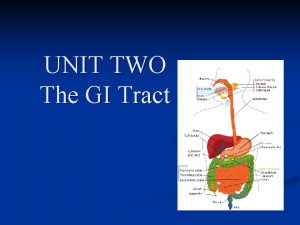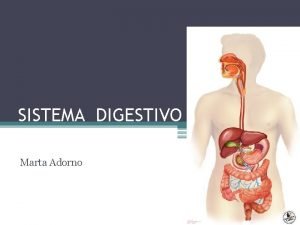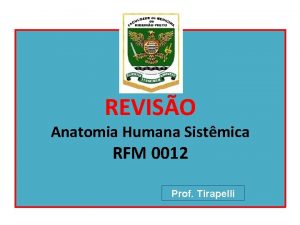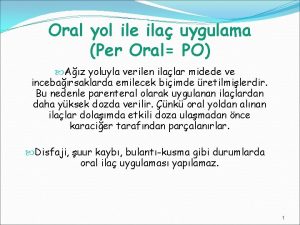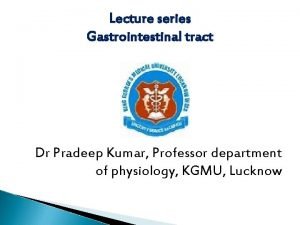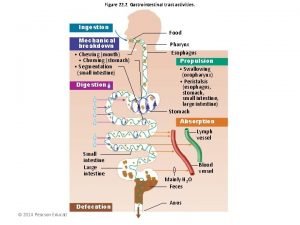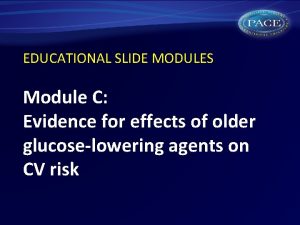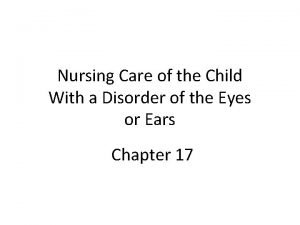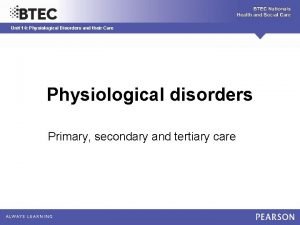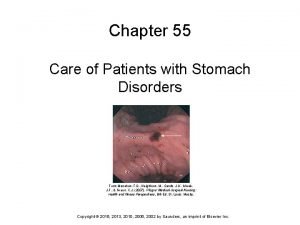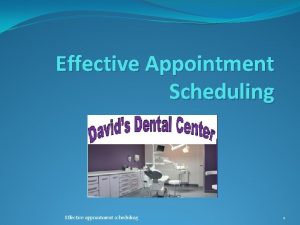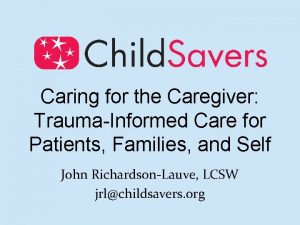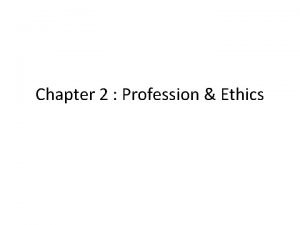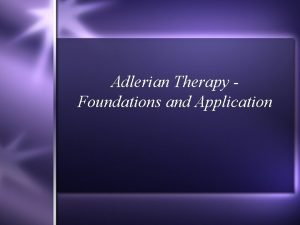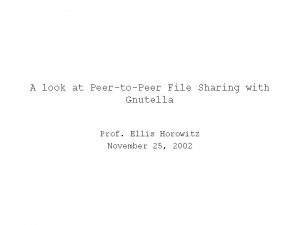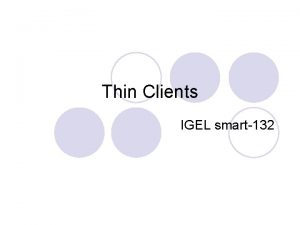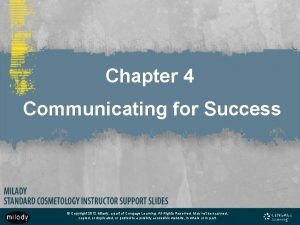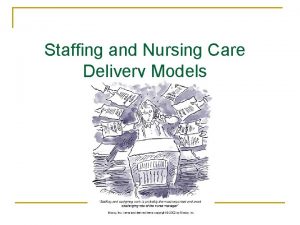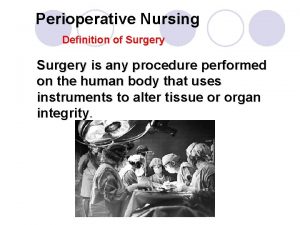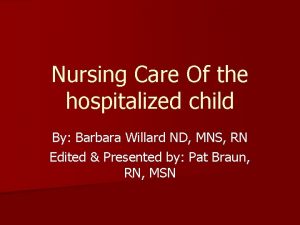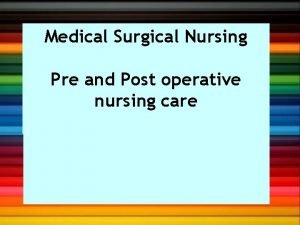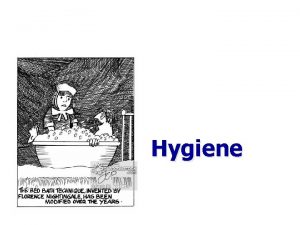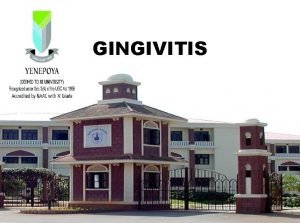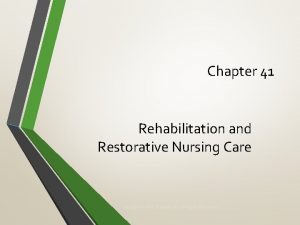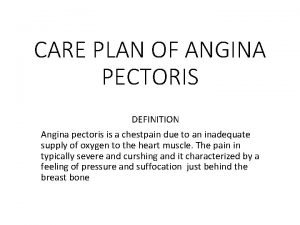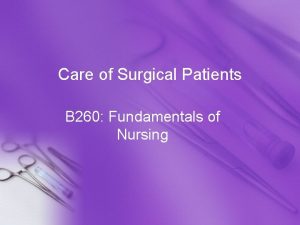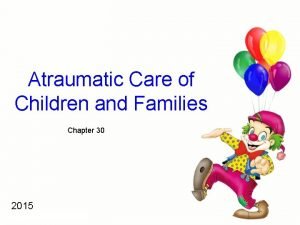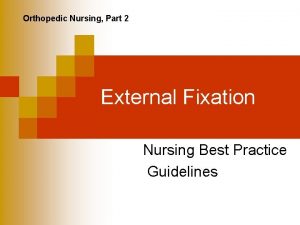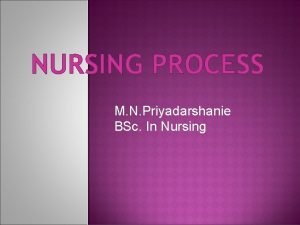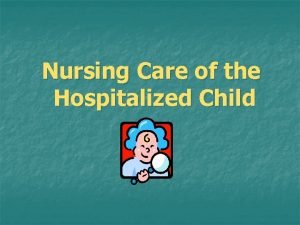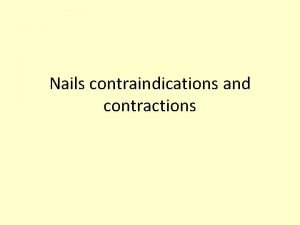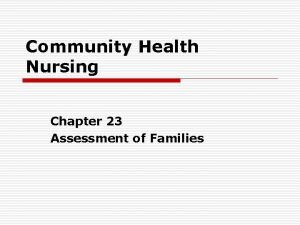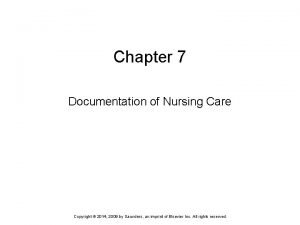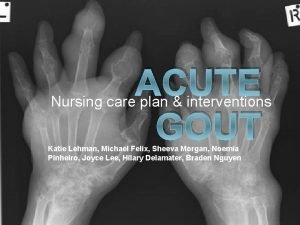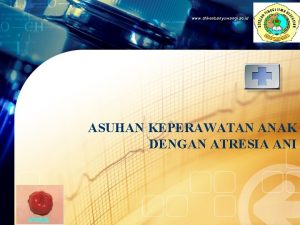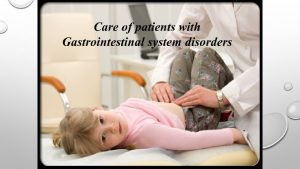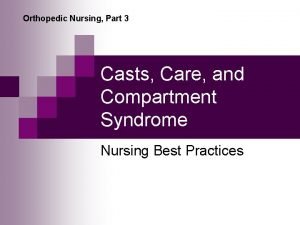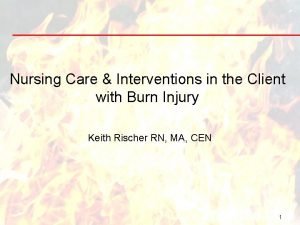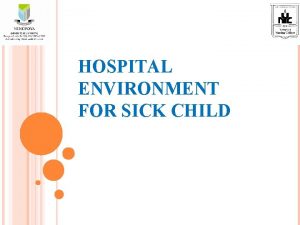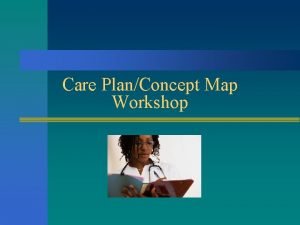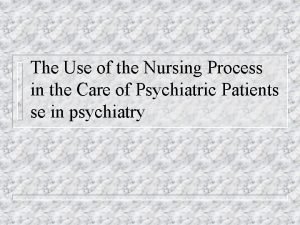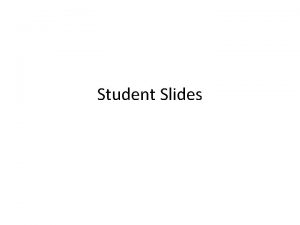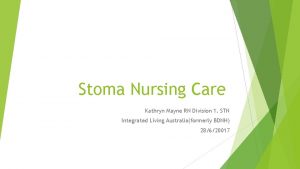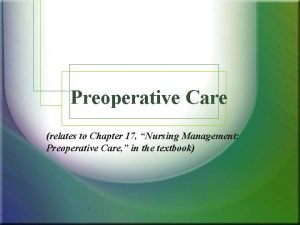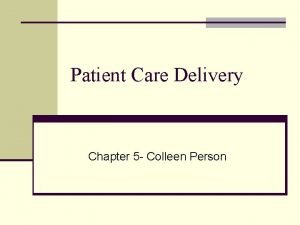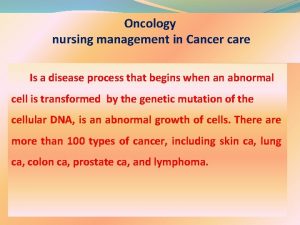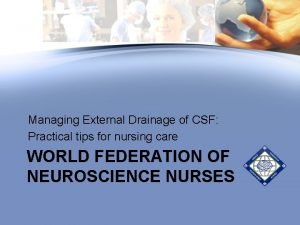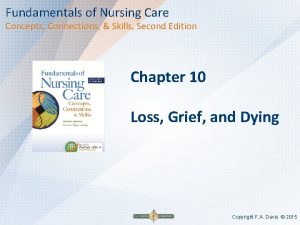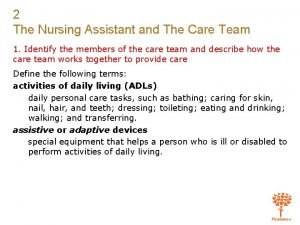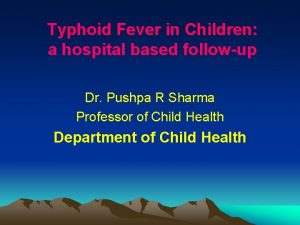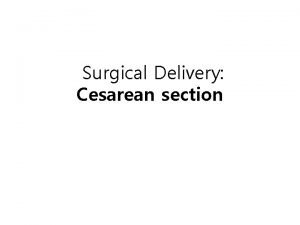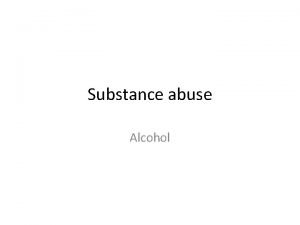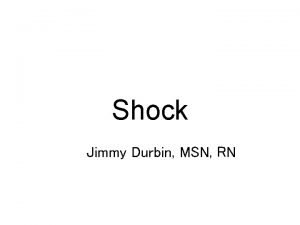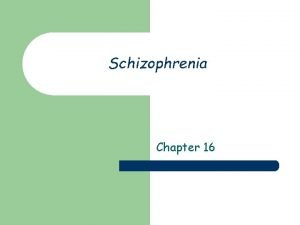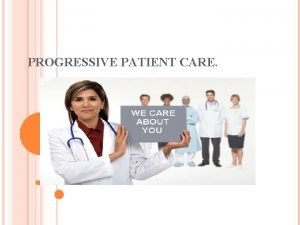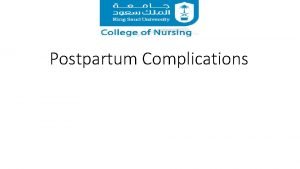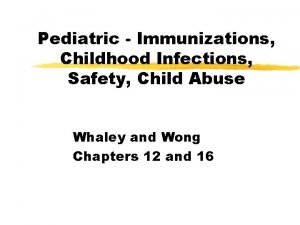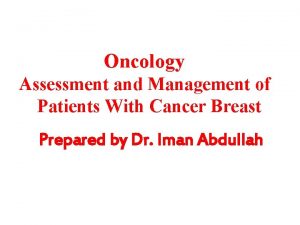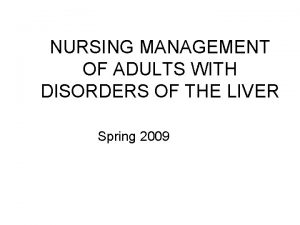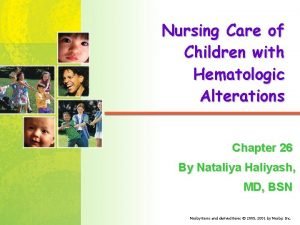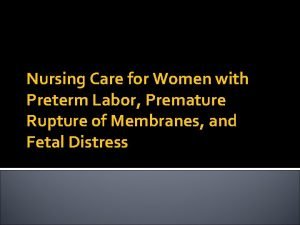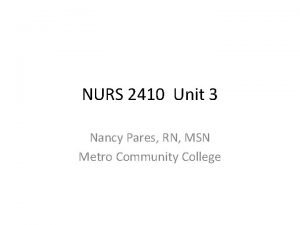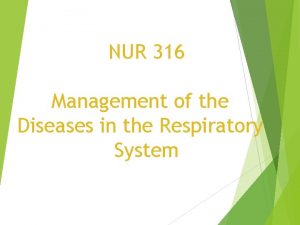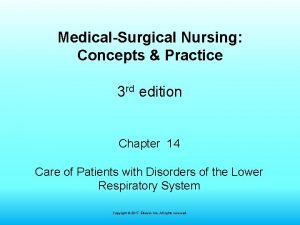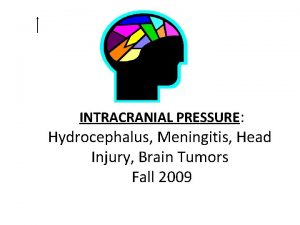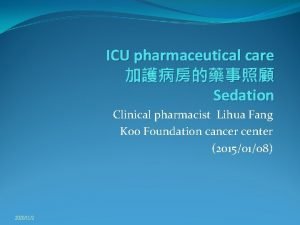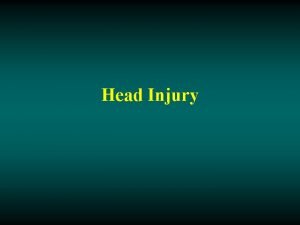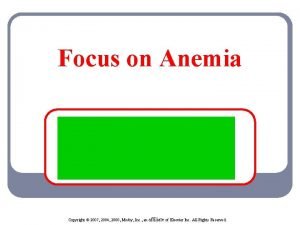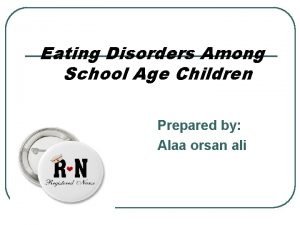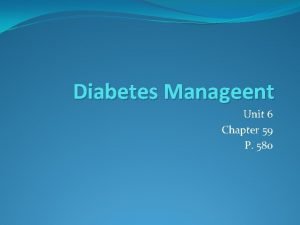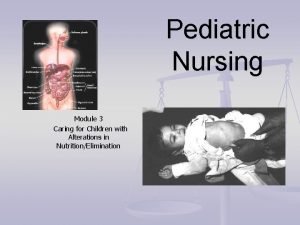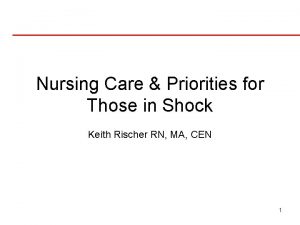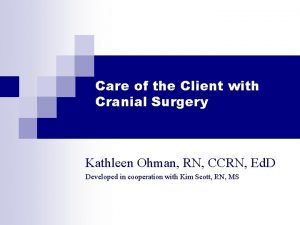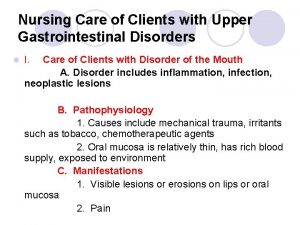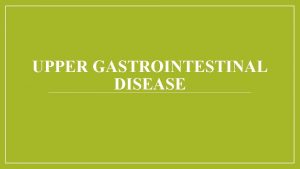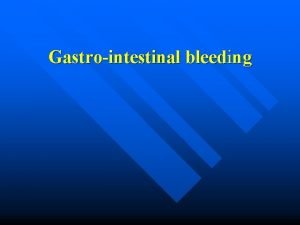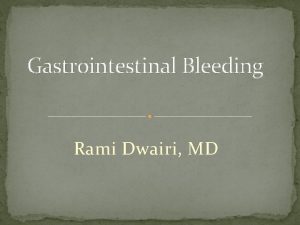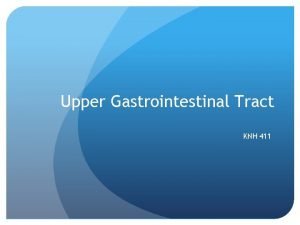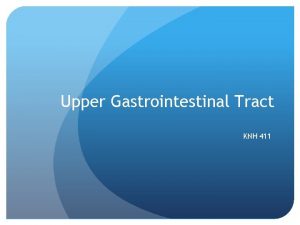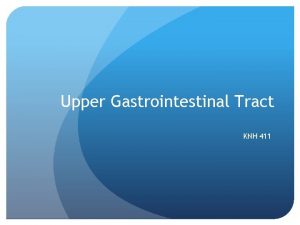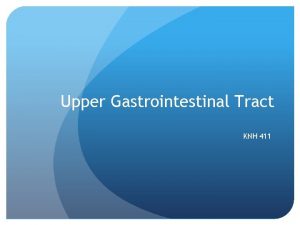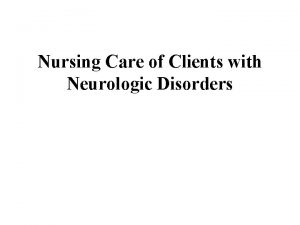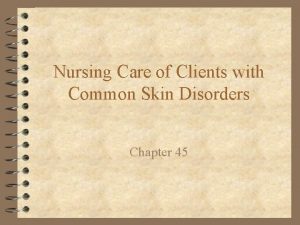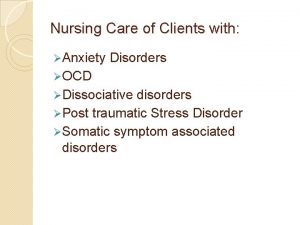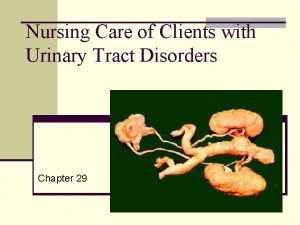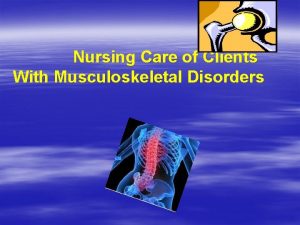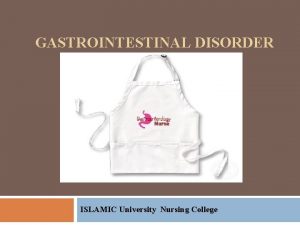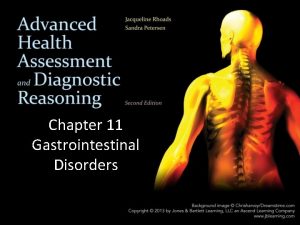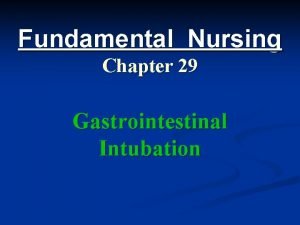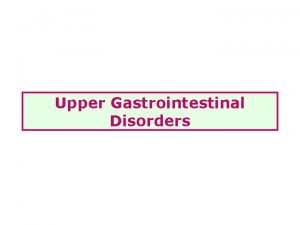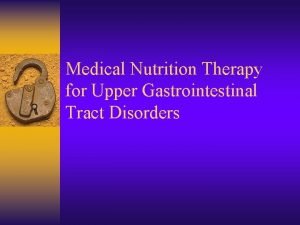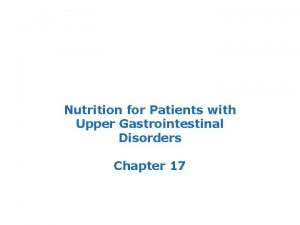Nursing Care of Clients with Upper Gastrointestinal Disorders

















































































































































- Slides: 145

Nursing Care of Clients with Upper Gastrointestinal Disorders l I. Care of Clients with Disorder of the Mouth A. Disorder includes inflammation, infection, neoplastic lesions B. Pathophysiology 1. Causes include mechanical trauma, irritants such as tobacco, chemotherapeutic agents 2. Oral mucosa is relatively thin, has rich blood supply, exposed to environment C. Manifestations 1. Visible lesions or erosions on lips or oral mucosa 2. Pain

Nursing Care of Clients with Upper Gastrointestinal Disorders l D. Collaborative Care 1. Direct observation to investigate any problems; determine underlying cause and any coexisting diseases 2. Any undiagnosed oral lesion present for > 1 week and not responding to treatment should be evaluated for malignancy 3. General treatment includes mouthwashes or treatments to cleanse and relieve irritation a. Alcohol bases mouthwashes cause pain and burning b. Sodium bicarbonate mouthwashes are effective without pain 4. Specific treatments according to type of infection a. Fungal (candidiasis): nystatin “swish and swallow” or clotrimazole lozenges l b. Herpetic lesions: topical or oral acyclovir

Nursing Care of Clients with Upper Gastrointestinal Disorders E. Nursing Care 1. Goal: to relieve pain and symptoms, so client can continue food and fluid intake in health care facility and at home 2. Impaired oral mucous membrane l a. Assess clients at high risk l b. Assist with oral hygiene post eating, bedtime l c. Teach to limit irritants: tobacco, alcohol, spicy foods 3. Imbalanced nutrition: less than body requirements l a. Assess nutritional intake; use of straws l b. High calorie and protein diet according to client preferences


Client with Oral Cancer 1. Background l a. Uncommon (5% of all cancers) but has high rate of morbidity, mortality l b. Highest among males over age 40 l c. Risk factors include smoking and using oral tobacco, drinking alcohol, marijuana use, occupational exposure to chemicals, viruses (human papilloma virus)

Client with Oral Cancer 2. Pathophysiology l a. Squamous cell carcinomas l b. Begin as painless oral ulceration or lesion with irregular, ill-defined borders l c. Lesions start in mucosa and may advance to involve tongue, oropharynx, mandible, maxilla l d. Non-healing lesions should be evaluated for malignancy after one week of treatment

Client with Oral Cancer 3. Collaborative Care l a. Elimination of causative agents l b. Determination of malignancy with biopsy l c. Determine staging with CT scans and MRI l d. Based on age, tumor stage, general health and client’s preference, treatment may include surgery, chemotherapy, and/or radiation therapy l e. Advanced carcinomas may necessitate radical neck dissection with temporary or permanent tracheostomy; Surgeries may be disfiguring l f. Plan early for home care post hospitalization, teaching family and client care involved post surgery, refer to American Cancer Society, support groups

Client with Oral Cancer 4. Nursing Care a. Health promotion: l 1. Teach risk of oral cancer associated with all tobacco use and excessive alcohol use l 2. Need to seek medical attention for all nonhealing oral lesions (may be discovered by dentists); early precancerous oral lesions are very treatable b. Nursing Diagnoses l 1. Risk for ineffective airway clearance l 2. Imbalanced Nutrition: Less than body requirements l 3. Impaired Verbal Communication: establishment of specific communication plan and method should be done prior to any surgery l 4. Disturbed Body Image

Gastroesophageal Reflux Disease (GERD) 1. Definition l b. GERD common, affecting 15 – 20% of adults l c. 10% persons experience daily heartburn and indigestion l d. Because of location near other organs symptoms may mimic other illnesses including heart problems l a. Gastroesophageal reflux is the backward flow of gastric content into the esophagus.

Gastroesophageal Reflux Disease (GERD) 2. Pathophysiology l a. Gastroesophageal reflux results from transient relaxation or incompetence of lower esophageal sphincter, or increased pressure within stomach l b. Factors contributing to gastroesophageal reflux 1. Increased gastric volume (post meals) 2. Position pushing gastric contents close to gastroesophageal juncture (such as bending or lying down) 3. Increased gastric pressure (obesity or tight clothing) 4. Hiatal hernia

Gastroesophageal Reflux Disease (GERD) l c. Normally the peristalsis in esophagus and bicarbonate in salivary secretions neutralize any gastric juices (acidic) that contact the esophagus; during sleep and with gastroesophageal reflux esophageal mucosa is damaged and inflamed; prolonged exposure causes ulceration, friable mucosa, and bleeding; untreated there is scarring and stricture 3. Manifestations l a. Heartburn after meals, while bending over, or recumbent l b. May have regurgitation of sour materials in mouth, pain with swallowing l c. Atypical chest pain l d. Sore throat with hoarseness l e. Bronchospasm and laryngospasm




Gastroesophageal Reflux Disease (GERD) 4. Complications l a. Esophageal strictures, which can progress to dysphagia l b. Barrett’s esophagus: changes in cells lining esophagus with increased risk for esophageal cancer 5. Collaborative Care l a. Diagnosis may be made from history of symptoms and risks l b. Treatment includes 1. Life style changes 2. Diet modifications 3. Medications

Gastroesophageal Reflux Disease (GERD) 6. Diagnostic Tests l a. Barium swallow (evaluation of esophagus, stomach, small intestine) l b. Upper endoscopy: direct visualization; biopsies may be done l c. 24 -hour ambulatory p. H monitoring l d. Esophageal manometry, which measure pressures of esophageal sphincter and peristalsis l e. Esophageal motility studies


Gastroesophageal Reflux Disease (GERD) 7. Medications l a. Antacids for mild to moderate symptoms, e. g. Maalox, Mylanta, Gaviscon l b. H 2 -receptor blockers: decrease acid production; given BID or more often, e. g. cimetidine, ranitidine, famotidine, nizatidine l c. Proton-pump inhibitors: reduce gastric secretions, promote healing of esophageal erosion and relieve symptoms, e. g. omeprazole (prilosec); lansoprazole (Prevacid) initially for 8 weeks; or 3 to 6 months l d. Promotility agent: enhances esophageal clearance and gastric emptying, e. g. metoclopramide (reglan)

Gastroesophageal Reflux Disease 8. Dietary and Lifestyle Management l a. Elimination of acid foods (tomatoes, spicy, citrus foods, coffee) l b. Avoiding food which relax esophageal sphincter or delay gastric emptying (fatty foods, chocolate, peppermint, alcohol) l c. Maintain ideal body weight l d. Eat small meals and stay upright 2 hours post eating; no eating 3 hours prior to going to bed l e. Elevate head of bed on 6 – 8 blocks to decrease reflux l f. No smoking l g. Avoiding bending and wear loose fitting clothing

Gastroesophageal Reflux Disease (GERD) 9. Surgery indicated for persons not improved by diet and life style changes l a. Laparoscopic procedures to tighten lower esophageal sphincter l b. Open surgical procedure: Nissen fundoplication 10. Nursing Care l a. Pain usually controlled by treatment l b. Assist client to institute home plan



Hiatal Hernia 1. Definition l a. Part of stomach protrudes through the esophageal hiatus of the diaphragm into thoracic cavity l b. Predisposing factors include: ¡Increased intra-abdominal pressure ¡Increased age ¡Trauma ¡Congenital weakness ¡Forced recumbent position

Hiatal Hernia l c. Most cases are asymptomatic; incidence increases with age l d. Sliding hiatal hernia: gastroesophageal junction and fundus of stomach slide through the esophageal hiatus l e. Paraesophageal hiatal hernia: the gastroesophageal junction is in normal place but part of stomach herniates through esophageal hiatus; hernia can become strangulated; client may develop gastritis with bleeding


Hiatal Hernia 2. Manifestations: Similar to GERD 3. Diagnostic Tests l a. Barium swallow l b. Upper endoscopy 4. Treatment l a. Similar to GERD: diet and lifestyle changes, medications l b. If medical treatment is not effective or hernia becomes incarcerated, then surgery; usually Nissen fundoplication by thoracic or abdominal approach ¡ Anchoring the lower esophageal sphincter by wrapping a portion of the stomach around it to anchor it in place


Impaired Esophageal Motility 1. Types l a. Achalasia: characterized by impaired peristalsis of smooth muscle of esophagus and impaired relaxation of lower esophageal sphincter l b. Diffuse esophageal spasm: nonperistaltic contraction of esophageal smooth muscle 2. Manifestations: Dysphagia and/or chest pain 3. Treatment l a. Endoscopically guided injection of botulinum toxin ¡Denervates cholinergic nerves in the distal esophagus to stop spams l b. Balloon dilation of lower esophageal sphincter ¡ May place stents to keep esophagus open

Esophageal Cancer 1. Definition: Relatively uncommon malignancy with high mortality rate, usually diagnosed late 2. Pathophysiology l a. Squamous cell carcinoma 1. Most common affecting middle or distal portion of esophagus 2. More common in African Americans than Caucasians 3. Risk factors cigarette smoking and chronic alcohol use l b. Adenocarcinoma 1. Nearly as common as squamous cell affecting distal portion of esophagus 2. More common in Caucasians 3. Associated with Barrett’s esophagus, complication of chronic GERD and achalasia

Esophageal Cancer 3. Manifestations l a. Progressive dysphagia with pain while swallowing l b. Choking, hoarseness, cough l c. Anorexia, weight loss 4. Collaborative Care: Treatment goals l a. Controlling dysphagia l b. Maintaining nutritional status while treating carcinoma (surgery, radiation therapy, and/or chemotherapy

Esophageal Cancer 5. Diagnostic Tests l a. Barium swallow: identify irregular mucosal patterns or narrowing of lumen l b. Esophagoscopy: allow direct visualization of tumor and biopsy l c. Chest xray, CT scans, MRI: determine tumor metastases l d. Complete Blood Count: identify anemia l e. Serum albumin: low levels indicate malnutrition l f. Liver function tests: elevated with liver metastasis

Esophageal Cancer 6. Treatments: dependent on stage of disease, client’s condition and preference l a. Early (curable) stage: surgical resection of affected portion with anastomosis of stomach to remaining esophagus; may also include radiation therapy and chemotherapy prior to surgery l b. More advanced carcinoma: treatment is palliative and may include surgery, radiation and chemotherapy to control dysphagia and pain l c. Complications of radiation therapy include perforation, hemorrhage, stricture

Esophageal Cancer 7. Nursing Care: Health promotion; education regarding risks associated with smoking and excessive alcohol intake 8. Nursing Diagnoses l a. Imbalanced Nutrition: Less than body requirements (may include enteral tube feeding or parenteral nutrition in hospital and home) l b. Anticipatory Grieving (dealing with cancer diagnosis) l c. Risk for Ineffective Airway Clearance (especially during postoperative period if surgery was done)

Peptic Ulcer Disease (PUD) Definition and Risk factors l a. Break in mucous lining of GI tract comes into contact with gastric juice; affects 10% of US population l b. Duodenal ulcers: most common; affect mostly males ages 30 – 55; ulcers found near pyloris l c. Gastric ulcers: affect older persons (ages 55 – 70); found on lesser curvature and associated with increased incidence of gastric cancer l d. Common in smokers, users of NSAIDS; familial pattern, ASA, alcohol, cigarettes

Peptic Ulcer Disease (PUD) 2. Pathophysiology l A. Ulcers or breaks in mucosa of GI tract occur with 1. H. pylori infection (spread by oral to oral, fecal-oral routes) damages gastric epithelial cells reducing effectiveness of gastric mucus 2. Use of NSAIDS: interrupts prostaglandin synthesis which maintains mucous barrier of gastric mucosa l b. Chronic with spontaneous remissions and exacerbations associated with trauma, infection, physical or psychological stress





Peptic Ulcer Disease l. Diagnosis ¡Endoscopy with cultures l. Looking for H. Pylori ¡Upper GI barium contrast studies ¡EGD-esophagogastroduodenoscopy ¡Serum and stool studies


Peptic Ulcer Disease (PUD) 3. Manifestations l a. Pain is classic symptom: gnawing, burning, aching hungerlike in epigastric region possibly radiating to back; occurs when stomach is empty and relieved by food (pain: food: relief pattern) l b. Symptoms less clear in older adult; may have poorly localized discomfort, dysphagia, weight loss; presenting symptom may be complication: GI hemorrhage or perforation of stomach or duodenum

Peptic Ulcer Disease l. Treatment ¡Rest and stress reduction ¡Nutritional management ¡Pharmacological management l. Antacids (Mylanta) • Neutralizes acids l. Proton pump inhibitors (omeprazole) • Block gastric acid secretion

Peptic Ulcer Disease l. Pharmacological management ¡Histamine blockers (Tagamet, Zantac) l. Blocks gastric acid secretion ¡Carafate l. Forms protective layer over the site ¡Mucosal barrier enhancers (bismuth subsalicylate , prostoglandins) l. Protect mucosa from injury ¡Antibiotics( ﻣﺘﺮﻭﻧیﺪﺍﺯﻭﻝ ﻭ ، کﻼﺭیﺘﺮﻭﻣﺎیﺴیﻦ ﺗﺘﺮﺍﺳیکﻠیﻦ , ) آﻤﻮکﺴی ﺳیﻠیﻦ l. Treat H. Pylori infection

Peptic Ulcer Disease l Surgical intervention ¡Minimally invasive gastrectomy l. Partial gastric removal with laproscopic surgery ¡Bilroth I and II l. Removal of portions of the stomach ¡Vagotomy l. Cutting of the vagus nerve to decrease acid secretion ¡Pyloroplasty l. Widens the pyloric sphincter

Billroth I

Billroth II

Peptic Ulcer Disease (PUD) Complications l a. Hemorrhage: frequent in older adult: hematemesis, melena, hematochezia (blood in stool); weakness, fatigue, dizziness, orthostatic hypotension and anemia; with significant bleed loss may develop hypovolemic shock l b. Obstruction: gastric outlet (pyloric sphincter) obstruction: edema surrounding ulcer blocks GI tract from muscle spasm or scar tissue 1. Gradual process 2. Symptoms: feelings of epigastric fullness, nausea, worsened ulcer symptoms 4.

Peptic Ulcer Disease l c. Perforation: ulcer erodes through mucosal wall and gastric or duodenal contents enter peritoneum leading to peritonitis; chemical at first (inflammatory) and then bacterial in 6 to 12 hours 1. Time of ulceration: severe upper abdominal pain radiating throughout abdomen and possibly to shoulder 2. Abdomen becomes rigid, boardlike with absent bowel sounds; symptoms of shock 3. Older adults may present with mental confusion and non-specific symptoms

Upper GI Bleed l Mortality approx 10% l Predisposing factors include: drugs, esophageal varacies, esophagitis, PUD, gastritis and carcinoma

Upper GI Bleed l Signs and Symptoms ¡Coffee ground vomitus ¡Black, tarry stools ¡Melena ¡Decreased B/P ¡Vertigo ¡Drop in Hct, Hgb ¡Confusion ¡syncope

Upper GI Bleed l Diagnosis ¡History ¡Blood, stool, vomitus studies ¡Endoscopy

Upper GI Bleed l Treatments ¡Volume replacement l. Crystalloids- normal saline l. Blood transfusions ¡NG lavage ¡EGD l. Endoscopic treatment of bleeding ulcer l. Sclerotheraphy-injecting bleeding ulcer with necrotizing agent to stop bleeding( ethanol amin)

Upper GI Bleed l Treatments ¡Sengstaken-Blakemore tube l. Used with bleeding esophageal varacies ¡Surgical intervention l. Removal of part of the stomach

Sengstaken-Blakemore Tube

Cancer of Stomach 1. Incidence l a. Worldwide common cancer, but less common in US l b. Incidence highest among Hispanics, African Americans, Asian Americans, males twice as often as females l c. Older adults of lower socioeconomic groups higher risk 2. Pathophysiology l a. Adenocarcinoma most common form involving mucus-producing cells of stomach in distal portion l b. Begins as localized lesion (in situ) progresses to mucosa; spreads to lymph nodes and metastasizes early in disease to liver, lungs, ovaries, peritoneum

Cancer of Stomach 3. l l l 4. l l l Risk Factors a. H. pylori infection b. Genetic predisposition c. Chronic gastritis, pernicious anemia, gastric polyps d. Achlorhydria (lack of hydrochloric acid) e. Diet high in smoked foods and nitrates Manifestations a. Disease often advanced with metastasis when diagnosed b. Early symptoms are vague: early satiety, anorexia, indigestion, vomiting, pain after meals not responding to antacids c. Later symptoms weight loss, cachexia (wasted away appearance), abdominal mass, stool positive for occult blood

Cancer of Stomach 5. Collaborative Care a. Support client through testing b. Assist client to maintain adequate nutrition 6. Diagnostic Tests a. CBC indicates anemia b. Upper GI series, ultrasound identifies a mass c. Upper endoscopy: visualization and tissue biopsy of lesion

Cancer of Stomach 7. Treatment l a. Surgery, if diagnosis made prior to metastasis 1. Partial gastrectomy with anastomosis to duodenum: Bilroth I or gastroduodenostomy 2. Partial gastrectomy with anastomosis to jejunum: Bilroth II or gastrojejunostomy 3. Total gastrectomy (if cancer diffuse but limited to stomach) with esophagojejunostomy

Cancer of Stomach b. Complications associated with gastric surgery l 1. Dumping Syndrome a. Occurs with partial gastrectomy; hypertonic, undigested chyme bolus rapidly enters small intestine and pulls fluid into intestine causing decrease in circulating blood volume and increased intestinal peristalsis and motility b. Manifestations 5 – 30 minutes after meal: nausea with possible vomiting, epigastric pain and cramping, borborygmi, and diarrhea; client becomes tachycardic, hypotensive, dizzy, flushed, diaphoretic c. Manifestations 2 – 3 hours after meal: symptoms of hypoglycemia in response to excessive release of insulin that occurred from rise in blood glucose when chyme entered intestine

Cancer of Stomach d. Treatment: dietary pattern to delay gastric emptying and allow smaller amounts of chyme to enter intestine l 1. Liquids and solids taken separately l 2. Increased amounts of fat and protein l 3. Carbohydrates, especially simple sugars, reduced l 4. Client to rest recumbent or semi-recumbent 30 – 60 minutes after eating l 5. Anticholinergics(hyosin), sedatives, antispasmodic medications may be added(colofac) l 6. Limit amount of food taken at one time

Cancer of the Stomach l Common post-op complications ¡Pneumonia ¡Anastomotic leak ¡Hemorrhage ¡Relux aspiration ¡Sepsis ¡Reflux gastritis ¡Paralytic ileus ¡Bowel obstruction ¡Wound infection ¡Dumping syndrome

Cancer of Stomach l Nutritional problems related to rapid entry of food into the bowel and the shortage of intrinsic factor l 1 Anemia: iron deficiency and/or pernicious l 2 Folic acid deficiency l 3. Poor absorption of calcium, vitamin D c. Radiation and/or chemotherapy to control metastasic spread d. Palliative treatment including surgery, chemotherapy; client may have gastrostomy or jejunostomy tube inserted 7. Nursing Diagnoses l a. Imbalanced Nutrition: Less than body requirement: consult dietician since client at risk for protein-calorie malnutrition l b. Anticipatory Grieving

Diagnostic Evaluation l Lower GI tract studies: ¡Barium Enema: detect polyps, tumors, lesions of colon ¡Radiopaque substance instilled rectally ¡Gastrografin (water-soluble iodine contrast) used in inflammatory disease or perforated colon l Nursing Interventions: May vary according to MD orders ¡Bowel cleansing 1 -2 days before, clear liquid diet day before, NPO after midnight, enema until clear morning of l Computed Tomography: cross-sectional images l Nursing Interventions: NPO for 6 -8 hrs prior, assess for allergies to contrast dye

Diagnostic Evaluation l Magnetic Resonance Imaging: Noninvasive, uses magnetic fields and radio waves: ¡Useful in evaluating soft tissues, vessels, neoplasm ¡Contraindicated for pts with pacemakers, metal implants l Nursing Interventions: NPO for 6 -8 hrs prior, remove all jewelry, procedure takes 30 -90 minutes, close fitting scanner may cause feelings of claustrophobia l Anoscopy, Proctoscopy, Sigmoidoscopy: ¡Viewing of lower colon through rigid or flexible scope l Nursing Interventions: Minimal bowel cleansing, monitor vital signs during and after procedure

Diagnostic Evaluation l Colonoscopy: Direct visual inspection of colon to cecum ¡Flexible fiberoptic colonoscope, can obtain biopsies and remove polyps ¡Usually takes one hour, pt on left side, legs drawn toward chest l Nursing Interventions: May vary according to MD orders ¡Bowel cleansing : clear liquids day before, Informed consent, NPO night before, IV midazolam (Versed) for sedation. ¡During procedure monitor vital signs, O 2 saturation, color and temp of skin, level of consciousness, vagal response

Gerontologic Considerations l Oral Cavity ¡Tooth loss or decay ¡Atrophy of taste buds l Esophagus ¡Weakened gag reflex l Stomach ¡Decrease gastric secretions ¡Decrease motility l Small Intestine ¡Atrophy of muscle and mucosal surfaces l Large Intestine ¡Decrease mucus production ¡Decrease tone of anal sphincter

Nursing Care of Clients with Bowel Disorders Factors affecting bodily function of elimination A. GI tract l 1. Food intake l 2. Bacterial flora in bowel B. Indirect l 1. Psychologic stress l 2. Voluntary postponement of defecation C. Normal bowel elimination pattern l 1. l 2. Varies with the individual 2 – 3 times daily to 3 stools per week

Irritable Bowel Syndrome (IBS) (spastic bowel, functional colitis) Definition l a. Functional GI tract disorder without identifiable cause characterized by abdominal pain and constipation, diarrhea, or both l b. Affects up to 20% of persons in Western civilization; more common in females

Irritable Bowel Syndrome (IBS) (spastic bowel, functional colitis) Pathophysiology l a. Appears there is altered CNS regulation of motor and sensory functions of bowel 1. Increased bowel activity in response to food intake, hormones, stress 2. Increased sensations of chyme movement through gut 3. Hypersecretion of colonic mucus l b. Lower visceral pain threshold causing abdominal pain and bloating with normal levels of gas l c. Some linkage of depression and anxiety

Irritable Bowel Syndrome (IBS) (spastic bowel, functional colitis) Manifestations l a. Abdominal pain relieved by defecation; may be colicky, occurring in spasms, dull or continuous l b. Altered bowel habits including frequency, hard or watery stool, straining or urgency with stooling, incomplete evacuation, passage of mucus; abdominal bloating, excess gas l c. Nausea, vomiting, anorexia, fatigue, headache, anxiety l d. Tenderness over sigmoid colon upon palpation 4. Collaborative Care l a. Management of distressing symptoms l b. Elimination of precipitating factors, stress reduction

Irritable Bowel Syndrome (IBS) (spastic bowel, functional colitis) 5. l l Diagnostic Tests: to find a cause for client’s abdominal pain, changes in feces elimination a. Stool examination for occult blood, ova and parasites, culture b. CBC with differential, Erythrocyte Sedimentation Rate (ESR): to determine if anemia, bacterial infection, or inflammatory process c. Sigmoidoscopy or colonoscopy 1. Visualize bowel mucosa, measure intraluminal pressures, obtain biopsies if indicated 2. Findings with IBS: normal appearance increased mucus, intraluminal pressures, marked spasms, possible hyperemia without lesions d. Small bowel series (Upper GI series with small bowel-follow through) and barium enema: examination of entire GI tract; IBS: increased motility

Irritable Bowel Syndrome (IBS) (spastic bowel, functional colitis) Medications l a. Purpose: to manage symptoms l b. Bulk-forming laxatives: reduce bowel spasm, normalize bowel movement in number and form l c. Anticholinergic drugs (dicyclomine (Bentyl), hyoscyamine) to inhibit bowel motility and prevent spasms; given before meals l d. Antidiarrheal medications (loperamide (Imodium), diphenoxylate (Lomotil): prevent diarrhea prophylactically l e. Antidepressant medications l f. Research: medications altering serotonin receptors in GI tract to stimulate peristalsis of the GI tract

Irritable Bowel Syndrome (IBS) (spastic bowel, functional colitis) Dietary Management l a. Often benefit from additional dietary fiber: adds bulk and water content to stool reducing diarrhea and constipation l b. Some benefit from elimination of lactose, fructose, sorbitol l c. Limiting intake of gas-forming foods, caffeinated beverages 8. Nursing Care l a. Contact in health environments outside acute care l b. Home care focus on improving symptoms with changes of diet, stress management, medications; seek medical attention if serious changes occur

Peritonitis Definition l a. Inflammation of peritoneum, lining that covers wall (parietal peritoneum) and organs (visceral peritoneum) of abdominal cavity l b. Enteric bacteria enter the peritoneal cavity through a break of intact GI tract (e. g. perforated ulcer, ruptured appendix)

Peritonitis l Causes include: ¡Ruptured appendix ¡Perforated bowel secondary to PUD ¡Diverticulitis ¡Gangrenous gall bladder ¡Ulcerative colitis ¡Trauma ¡Peritoneal dialysis

Peritonitis Pathophysiology l a. Peritonitis results from contamination of normal sterile peritoneal cavity with infections or chemical irritant l b. Release of bile or gastric juices initially causes chemical peritonitis; infection occurs when bacteria enter the space l c. Bacterial peritonitis usually caused by these bacteria (normal bowel flora): Escherichia coli, Klebsiella, Proteus, Pseudomonas l d. Inflammatory process causes fluid shift into peritoneal space (third spacing); leading to hypovolemia, then septicemia

Peritonitis 3. Manifestations l a. Depends on severity and extent of infection, age and health of client l b. Presents with “acute abdomen” 1. Abrupt onset of diffuse, severe abdominal pain 2. Pain may localize near site of infection (may have rebound tenderness) 3. Intensifies with movement l c. Entire abdomen is tender with boardlike guarding or rigidity of abdominal muscle

Peritonitis l d. paralytic ileus; l bowel sounds are diminished or absent l distention; nausea and vomiting l e. Systemically: fever, malaise, tachycardia and tachypnea, restlessness, disorientation, oliguria with dehydration and shock l f. Older or immunosuppressed client may have 1. Few of classic signs 2. Increased confusion and restlessness 3. Decreased urinary output 4. Vague abdominal complaints 5. At risk for delayed diagnosis and higher mortality rates

Peritonitis 4. Complications l a. mortality rate overall 40% l b. Abscess l c. Fibrous adhesions l d. Septicemia, septic shock; hypovolemic shock 5. Collaborative Care l a. Diagnosis and identifying and treating cause l b. Prevention of complications

Peritonitis 6. Diagnostic Tests l a. WBC with differential: elevated WBC to 20, 000; shift to left l b. Blood cultures: identify bacteria in blood l c. Liver and renal function studies, serum electrolytes: evaluate effects of peritonitis l d. Abdominal xrays: detect intestinal distension, air-fluid levels, free air under diaphragm (sign of GI perforation) l e. Diagnostic paracentesis

Medications l a. Antibiotics 1. Broad-spectrum before definitive culture results identifying specific organism(s) causing infection 2. Specific antibiotic(s) treating causative pathogens l b. Analgesics

Peritonitis 8. Surgery l a. Laparotomy to treat cause (close perforation, removed inflamed tissue) l b. Peritoneal Lavage: washing out peritoneal cavity with copious amounts of warm isotonic fluid during surgery to dilute residual bacterial and remove gross contaminants l c. Often have drain in place and/or incision left unsutured to continue drainage

Peritonitis 9. Treatment l a. Intravenous fluids and electrolytes to maintain vascular volume and electrolyte balance l b. Bed rest in Fowler’s position to localize infection and promote lung ventilation l c. Intestinal decompression with nasogastric tube or intestinal tube connected to suction l 1. Relieves abdominal distension secondary to paralytic ileus l 2. NPO with intravenous fluids while having nasogastric suction

Peritonitis 10. Nursing Diagnoses l a. Pain l b. Deficient Fluid Volume: often on hourly output; nasogastric drainage is considered when ordering intravenous fluids l c. Ineffective Protection l d. Anxiety 11. Home Care l a. Client may have prolonged hospitalization l b. Home care often includes l 1. Wound care l 2. Home health referral l 3. Home intravenous antibiotics


Neoplastic Disorders Background l 1. Large intestine and rectum most common GI site affected by cancer l 2. Colon cancer is second leading cause of death from cancer in U. S. B. Client with Polyps 1. Definition l a. Polyp is mass of tissue arising from bowel wall and protruding into lumen l b. Most often occur in sigmoid and rectum l c. 30% of people over 50 have polyps

Neoplastic Disorders Pathophysiology la. Most polyps are adenomas, benign but considered premalignant; < 1% become malignant but all colorectal cancers arise from these polyps lb. Familial polyposis is uncommon autosomal dominant genetic disorder with hundreds of adenomatous polyps throughout large intestine; untreated, near 100% malignancy by age 40

Client with Polyps Manifestations l a. Most asymptomatic l b. Intermittent painless rectal bleeding is most common presenting symptom Collaborative Care l a. Diagnosis is based on colonoscopy l b. Most reliable since allows inspection of entire colon with biopsy or polypectomy if indicated l c. Repeat every 3 years since polyps recur

Client with Polyps Nursing Care la. All clients advised to have screening colonoscopy at age 50 and every 5 years thereafter lb. Bowel preparation ordered prior to colonoscopy with cathartics and/or enemas

Polyps

Client with Colorectal Cancer Definition l a. Third most common cancer diagnosed l b. Affects sexes equally l c. Five-year survival rate is 90%, with early diagnosis and treatment Risk Factors l a. Family history l b. Inflammatory bowel disease l c. Diet high in fat, calories, protein


Client with Colorectal Cancer Manifestations la. Often produces no symptoms until it is advanced lb. Presenting manifestation is bleeding; also change in bowel habits (diarrhea or constipation); pain, anorexia, weight loss, palpable abdominal or rectal mass; anemia

Colon Cancer

Client with Colorectal Cancer Complications l a. Bowel obstruction l b. Perforation of bowel by tumor, peritonitis l c. Direct extension of cancer to adjacent organs; reoccurrences within 4 years Screening l a. Digital exam beginning at age 40, annually l b. Fecal occult blood testing beginning at age 50, annually l c. Colonoscopies or sigmoidoscopies beginning at age 50, every 3 – 5 years

Client with Colorectal Cancer Diagnostic Tests l a. CBC: anemia from blood loss, tumor growth l b. Fecal occult blood (guiac or Hemoccult testing): all colorectal cancers bleed intermittently l c. Carcinoembryonic antigen (CEA): not used as screening test, but is a tumor marker and used to estimate prognosis, monitor treatment l d. Colonoscopy or sigmoidoscopy; tissue biopsy of suspicious lesions, polyps l e. Chest xray, CTscans, MRI, ultrasounds: to determine tumor depth, organ involvement, metastasis

Client with Colorectal Cancer l Pre-op care ¡Consult with ET nurse if ostomy is planned ¡Bowel prep with Go. Lytely ¡NPO ¡NG

Client with Colorectal Cancer Surgery l a. Surgical resection of tumor, adjacent colon, and regional lymph nodes is treatment of choice l b. Whenever possible anal sphincter is preserved and colostomy avoided; anastomosis of remaining bowel is performed l c. Tumors of rectum are treated with abdominoperineal resection (A-P resection) in which sigmoid colon, rectum, and anus are removed through abdominal and perineal incisions and permanent colostomy created

Client with Colorectal Cancer Colostomy Named for area of colon is which formed l a. Sigmoid colostomy: used with abdominoperineal resection formed on LLQ l b. Double-barrel colostomy: 2 stomas: proximal for feces diversion; distal is mucous fistula l c. Transverse loop colostomy: emergency procedure; loop suspended over a bridge; temporary l d. Hartman procedure: Distal portion is left in place and oversewn; only proximal colostomy is brought to abdomen as stoma; temporary; colon reconnected at later time when client ready for surgical repair 1.

Client with Colorectal Cancer l Post-op care ¡Pain ¡NG tube ¡Wound management l. Stoma • Should be pink and moist • Dark red or black indicates ischemic necrosis • Look for excessive bleeding • Observe for possible separation of suture securing stoma to abdominal wall

Client with Colorectal Cancer l Post-op care ¡Evaluate stool after 2 -4 days postop l. Ascending stoma (right side) • Liquid stool l. Transverse stoma • Pasty l. Descending stoma • Normal, solid stool




End stoma with Hartmann’s pouch

Good stoma Bad stoma

Stomal prolapse





cholecystitis












l. The end

Client with Intestinal Obstruction Definition l a. May be partial or complete obstruction l b. Failure of intestinal contents to move through the bowel lumen; most common site is small intestine l c. With obstruction, gas and fluid accumulate proximal to and within obstructed segment causing bowel distention l d. Bowel distention, vomiting, third-spacing leads to hypovolemia, hypokalemia, renal insufficiency, shock

Client with Intestinal Obstruction Pathophysiology a. Mechanical 1. Problems outside intestines: adhesions (bands of scar tissue), hernias 2. Problems within intestines: tumors, IBD 3. Obstruction of intestinal lumen (partial or complete) l a. Intussusception: telescoping bowel l b. Volvulus: twisted bowel l c. Foreign bodies l d. Strictures

Client with Intestinal Obstruction Functional 1. Failure of peristalsis to move intestinal contents: adynamic ileus (paralytic ileus, ileus) due to neurologic or muscular impairment 2. Accounts for most bowel obstructions 3. Causes include l a. Post gastrointestinal surgery l b. Tissue anoxia or peritoneal irritation from hemorrhage, peritonitis, or perforation l c. Hypokalemia l d. Medications: narcotics, anticholinergic drugs, antidiarrheal medications l e. Spinal cord injuries, uremia, alterations in electrolytes

Client with Intestinal Obstruction a. b. c. l l d. l l e. Manifestations Small Bowel Obstruction Vary depend on level of obstruction and speed of development Cramping or colicky abdominal pain, intermittent, intensifying Vomiting 1. Proximal intestinal distention stimulates vomiting center 2. Distal obstruction vomiting may become feculent Bowel sounds 1. Early in course of mechanical obstruction: borborygmi and high-pitched tinkling, may have visible peristaltic waves 2. Later silent; with paralytic ileus, diminished or absent bowel sounds throughout Signs of dehydration

Client with Intestinal Obstruction Complications l a. Hypovolemia and hypovolemic shock can result in multiple organ dysfunction (acute renal failure, impaired ventilation, death) l b. Strangulated bowel can result in gangrene, perforation, peritonitis, possible septic shock l c. Delay in surgical intervention leads to higher mortality rate

Client with Intestinal Obstruction Large Bowel Obstruction l a. Only accounts for 15% of obstructions l b. Causes include cancer of bowel, volvulus, diverticular disease, inflammatory disorders, fecal impaction l c. Manifestations: deep, cramping pain; severe, continuous pain signals bowel ischemia and possible perforation; localized tenderness or palpable mass may be noted

Client with Intestinal Obstruction Collaborative Care l a. Relieving pressure and obstruction l b. Supportive care Diagnostic Tests a. Abdominal Xrays and CT scans with contrast media l 1. Show distended loops of intestine with fluid and /or gas in small intestine, confirm mechanical obstruction; indicates free air under diaphragm l 2. If CT with contrast media meglumine diatrizoate (Gastrografin), check for allergy to iodine, need BUN and Creatinine to determine renal function b. Laboratory testing to evaluate for presence of infection and electrolyte imbalance: WBC, Serum amylase, osmolality, electrolytes, arterial blood gases c. Barium enema or colonoscopy/sigmoidoscopy to identify large bowel obstruction Gastrointestinal Decompression l a. Treatment with nasogastric or long intestinal tube provides bowel rest and removal of air and fluid l b. Successfully relieves many partial small bowel obstructions

Client with Intestinal Obstruction Surgery l a. Treatment for complete mechanical obstructions, strangulated or incarcerated obstructions of small bowel, persistent incomplete mechanical obstructions l b. Preoperative care l 1. Insertion of nasogastric tube to relieve vomiting, abdominal distention, and to prevent aspiration of intestinal contents l 2. Restore fluid and electrolyte balance; correct acid and alkaline imbalances l 3. Laparotomy: inspection of intestine and removal of infarcted or gangrenous tissue l 4. Removal of cause of obstruction: adhesions, tumors, foreign bodies, gangrenous portion of intestines and anastomosis or creation of colostomy depending on individual case

Client with Intestinal Obstruction Nursing Care l a. Prevention includes healthy diet, fluid intake l b. Exercise, especially in clients with recurrent small bowel obstructions Nursing Diagnoses l a. Deficient Fluid Volume l b. Ineffective Tissue Perfusion, gastrointestinal l c. Ineffective Breathing Pattern Home Care l a. Home care referral as indicated l b. Teaching about signs of recurrent obstruction and seeking medical attention

Client with Diverticular Disease Definition l a. Diverticula are saclike projections of mucosa through muscular layer of colon mainly in sigmoid colon l b. Incidence increases with age; less than a third of persons with diverticulosis develop symptoms Risk Factors l a. Cultural changes in western world with diet of highly refined and fiber-deficient foods l b. Decreased activity levels l c. Postponement of defecation

Client with Diverticular Disease Pathophysiology l a. Diverticulosis is the presence of diverticula which form due to increased pressure within bowel lumen causing bowel mucosa to herniate through defects in colon wall, causing outpouchings l b. Muscle in bowel wall thickens narrowing bowel lumen and increasing intraluminal pressure l c. Complications of diverticulosis include hemorrhage and diverticulitis, the inflammation of the diverticular sac

Clients with Diverticular Disease l d. Diverticulitis: diverticulum in sigmoid colon irritated with undigested food and bacteria forming a hard mass (fecalith) that impairs blood supply leading to perforation l e. With microscopic perforation, inflammation is localized; more extensive perforation may lead to peritonitis or abscess formation

Diverticulits

Diverticulitis

Client with Diverticular Disease Manifestations l a. Pain, left-sided, mild to moderate and cramping or steady l b. Constipation or frequency of defecation l c. May also have nausea, vomiting, low-grade fever, abdominal distention, tenderness and palpable LLQ mass l d. Older adult may have vague abdominal pain Complications l a. Peritonitis l b. Abscess formation l c. Bowel obstruction l d. Fistula formation l e. Hemorrhage

Client with Diverticular Disease Collaborative Care: Focus is on management of symptoms and complications Diagnostic Tests l a. Abdominal Xray: detection of free air with perforation, location of abscess, fistula l b. Barium enema contraindicated in early diverticulitis due to risk of barium leakage into peritoneal cavity, but will confirm diverticulosis l c. Abdominal CT scan, sigmoidoscopy or colonscopy used in diagnosis of diverticulosis l d. WBC count with differential: leukocytosis with shift to left in diverticulitis l e. Hemocult or guiac testing: determine presence of occult blood

Client with Diverticular Disease Medications l a. Broad spectrum antibiotics against gram negative and anaerobic bacteria to treat acute diverticulitis, oral or intravenous route depending on severity of symptoms ¡ Flagyl plus Bactrim or Cipro l b. Analgesics for pain (non-narcotic) l c. Fluids to correct dehydration l d. Stool softener but not cathartic may be prescribed (nothing to increase pressure within bowel) l e. Anticholinergics to decrease intestinal hypermotility

Clients with Diverticular Disease Dietary Management l a. Diet modification may decrease risk of complications l b. High-fiber diet (bran, commercial bulk -forming products such as psyllium seed (Metamucil) or methycelluose) l c. Some clients advised against foods with small seeds which could obstruct diverticula

Client with Diverticular Disease Treatment for acute episode of diverticulitis l a. Client initially NPO with intravenous fluids (possibly TPN) l b. As symptoms subside reintroduce food: clear liquid diet, to soft, low-roughage diet psyillium seed products to soften stool and increase bulk l c. High fiber diet is resumed after full recovery Surgery l a. Surgical intervention indicated for clients with generalized peritonitis or abscess that does not respond to treatment l b. With acute infection, 2 stage Hartman procedure done with temporary colostomy; re-anastomosis performed 2 – 3 months later

Client with Diverticular Disease Nursing Care: Health promotion includes teaching high -fiber foods in diet generally, may be contraindicated for persons with known conditions Nursing Diagnoses l a. Impaired Tissue Integrity, gastrointestinal l b. Pain l c. Anxiety, related to unknown outcome of treatment, possible surgery Home Care l a. Teaching regarding prescribed diet, fluid intake, medications l b. Referral for home health care agency, if new colostomy client
 Nursing care for gastrointestinal disorders
Nursing care for gastrointestinal disorders Borborygmi
Borborygmi Nursing care of male patients with genitourinary disorders
Nursing care of male patients with genitourinary disorders Nursing interventions for obsessive compulsive disorder
Nursing interventions for obsessive compulsive disorder Nursing intervention of cataract
Nursing intervention of cataract Levels of care primary secondary tertiary quaternary
Levels of care primary secondary tertiary quaternary Embriologia del sistema gastrointestinal
Embriologia del sistema gastrointestinal Gastrointestinal tract
Gastrointestinal tract Chemotrypsinogen
Chemotrypsinogen Emt chapter 18 gastrointestinal and urologic emergencies
Emt chapter 18 gastrointestinal and urologic emergencies Chapter 15 the gastrointestinal system
Chapter 15 the gastrointestinal system Gastrointestinal hormones
Gastrointestinal hormones Sigid djuniawan
Sigid djuniawan Docimasia gastrointestinal de breslau
Docimasia gastrointestinal de breslau Pankreatik polipeptid
Pankreatik polipeptid Gastrointestinal medical terminology breakdown
Gastrointestinal medical terminology breakdown Focused gastrointestinal assessment
Focused gastrointestinal assessment Foregut midgut hindgut
Foregut midgut hindgut Gastrointestinal tract
Gastrointestinal tract Motilidad gastrointestinal
Motilidad gastrointestinal Gastrointestinal diagram
Gastrointestinal diagram Função digestiva
Função digestiva Identifique
Identifique Functional constipation vs hirschsprung
Functional constipation vs hirschsprung Peroral ilaç uygulama
Peroral ilaç uygulama Gastrointestinal structure
Gastrointestinal structure Gastrointestinal
Gastrointestinal Why does metformin cause gastrointestinal problems
Why does metformin cause gastrointestinal problems Structure of alimentary canal
Structure of alimentary canal Myringotomy incision
Myringotomy incision Nursing management of sleep disorders
Nursing management of sleep disorders Physiological disorders unit 14
Physiological disorders unit 14 Physiological disorders and their care
Physiological disorders and their care Chapter 55 care of patients with stomach disorders
Chapter 55 care of patients with stomach disorders Upper cape tech nursing program
Upper cape tech nursing program Today's public relations departments
Today's public relations departments Recruitment cold calling candidates script
Recruitment cold calling candidates script Principe de protection des clients
Principe de protection des clients Flux de données clients
Flux de données clients Typologie des clients insatisfaits
Typologie des clients insatisfaits Ibm thin clients
Ibm thin clients How to schedule appointments with clients
How to schedule appointments with clients Trauma-informed questions for clients
Trauma-informed questions for clients Assessment questions social work
Assessment questions social work Nudge for clients
Nudge for clients From a multicultural perspective some clients
From a multicultural perspective some clients Obligation of an engineer to the clients
Obligation of an engineer to the clients Sabre helps its clients through dashboards and analytics
Sabre helps its clients through dashboards and analytics Spitting in the client’s soup
Spitting in the client’s soup Courtland c lee
Courtland c lee Using bird dogs when prospecting for clients refers to
Using bird dogs when prospecting for clients refers to Shampoo chemistry
Shampoo chemistry Client needs assessment
Client needs assessment Gnutella clients
Gnutella clients Nachteile thin clients
Nachteile thin clients Web essentials
Web essentials 10 step consultation method milady
10 step consultation method milady Idt therapy
Idt therapy Facade pattern couples a subsystem from its clients
Facade pattern couples a subsystem from its clients Les dossiers clients
Les dossiers clients Total patient care nursing model
Total patient care nursing model Define nursing diagnosis
Define nursing diagnosis Nursing process in psychiatric nursing
Nursing process in psychiatric nursing Nursing care plans examples
Nursing care plans examples Modular nursing definition
Modular nursing definition Stages of schizophrenia
Stages of schizophrenia Vertical
Vertical Define perioperative nursing
Define perioperative nursing Nursing management preoperative care
Nursing management preoperative care Nursing care of hospitalized child
Nursing care of hospitalized child Post operative nursing care
Post operative nursing care Nail care procedure in nursing
Nail care procedure in nursing Nursing diagnosis for gingivitis
Nursing diagnosis for gingivitis Hernia nursing care plan
Hernia nursing care plan Chapter 41 rehabilitation and restorative nursing care
Chapter 41 rehabilitation and restorative nursing care Nursing diagnosis for angina
Nursing diagnosis for angina Post operative nursing care
Post operative nursing care Atraumatic care techniques
Atraumatic care techniques Atraumatic care
Atraumatic care Who is virginia henderson
Who is virginia henderson Somatic symptom disorder
Somatic symptom disorder External fixation device nursing care
External fixation device nursing care Nursing care plan case scenario
Nursing care plan case scenario Nursing care of hospitalized child
Nursing care of hospitalized child Contraindications of nail care in nursing
Contraindications of nail care in nursing Family care plan in community health nursing
Family care plan in community health nursing Fdar sample charting
Fdar sample charting Nursing diagnosis gout
Nursing diagnosis gout Nursing care logo
Nursing care logo Nursing interventions for endoscopy complications
Nursing interventions for endoscopy complications Minerva cast ortho
Minerva cast ortho Nursing care plan for burns
Nursing care plan for burns Sick child slideshare
Sick child slideshare Nursing care plan concept map
Nursing care plan concept map Nursing care plan for homicidal ideation
Nursing care plan for homicidal ideation Risk for aspiration
Risk for aspiration Stoma
Stoma Nursing management preoperative care
Nursing management preoperative care Primary nursing vs total patient care
Primary nursing vs total patient care Testicular cancer nursing interventions
Testicular cancer nursing interventions Dorothea e orem
Dorothea e orem Nursing management of liver cirrhosis
Nursing management of liver cirrhosis Powerlessness nursing diagnosis
Powerlessness nursing diagnosis Pulmonary embolism nursing diagnosis
Pulmonary embolism nursing diagnosis Patho
Patho Drainage nursing
Drainage nursing Fundamentals of nursing care concepts connections & skills
Fundamentals of nursing care concepts connections & skills Bucks traction
Bucks traction Nursing interventions for stroke patients
Nursing interventions for stroke patients The nursing assistant and the care team
The nursing assistant and the care team Nursing care plan for typhoid fever slideshare
Nursing care plan for typhoid fever slideshare Nursing diagnosis for lscs slideshare
Nursing diagnosis for lscs slideshare Stages of intoxication
Stages of intoxication Anaphylactic shock
Anaphylactic shock Catatonic behavior example
Catatonic behavior example What is progressive patient care
What is progressive patient care Nursing care plan for postpartum hemorrhage slideshare
Nursing care plan for postpartum hemorrhage slideshare Lochia slideshare
Lochia slideshare Nursing care plan of mumps
Nursing care plan of mumps Nursing care plan for breast cancer ppt
Nursing care plan for breast cancer ppt Nursing care for rheumatoid arthritis
Nursing care for rheumatoid arthritis Sengstaken blakemore tube nursing care
Sengstaken blakemore tube nursing care Nursing care plan for anemia slideshare
Nursing care plan for anemia slideshare Nursing care for preterm labor
Nursing care for preterm labor Nursing care plan for postpartum hemorrhage slideshare
Nursing care plan for postpartum hemorrhage slideshare Nursing diagnosis for tb
Nursing diagnosis for tb Nursing care plan for headache slideshare
Nursing care plan for headache slideshare Nursing care plan for pneumonia
Nursing care plan for pneumonia Preoperative nursing care for craniotomy
Preoperative nursing care for craniotomy Cvc care bundle checklist
Cvc care bundle checklist Battle's sign
Battle's sign Washington state nursing care quality assurance commission
Washington state nursing care quality assurance commission Nursing care plan for anemia slideshare
Nursing care plan for anemia slideshare Bulimia nervosa nursing care plan
Bulimia nervosa nursing care plan Nanda for dka
Nanda for dka Pyloric valve
Pyloric valve Patho
Patho Describe the care team and the chain of command
Describe the care team and the chain of command Steriotaxis
Steriotaxis Standard 3 care certificate
Standard 3 care certificate Ce atrage magnetul
Ce atrage magnetul Palliative care versus hospice care
Palliative care versus hospice care Animale care se inmultesc prin oua
Animale care se inmultesc prin oua Care sunt simturile prin care sunt evocate
Care sunt simturile prin care sunt evocate Care certificate 10 answers
Care certificate 10 answers Hip fracture care clinical care standard
Hip fracture care clinical care standard


